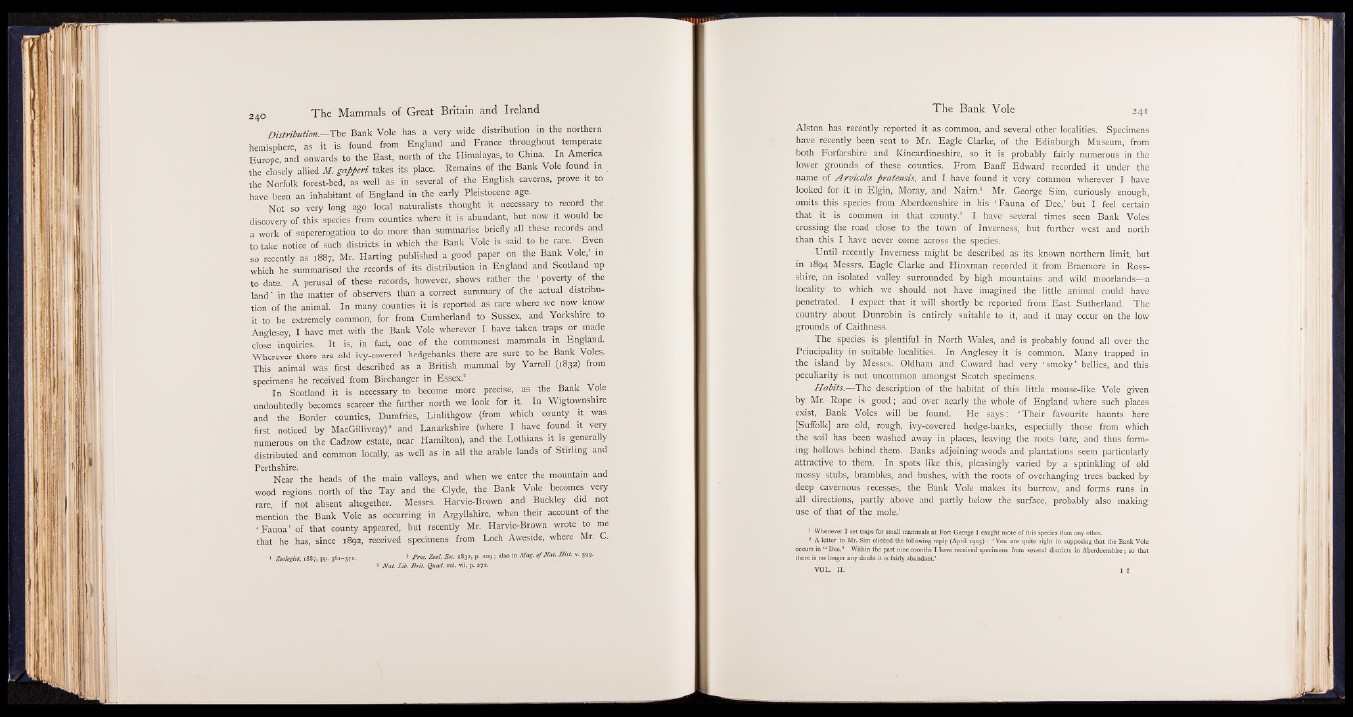
D istribution.—The Bank Vole has a very wide distribution in the northern
hemisphere, as it I found from England and France throughout temperate
Europe, and onwards to the East, north of the Himalayas, to China. In America
the closely allied M. gap peri takes its place. Remains of the Bank Vole found in
the Norfolk forest-bed, as well as in several of the English caverns, prove it to
have been an inhabitant of England in the early Pleistocene age.
Not Ii! very long ago local naturalists thought it . necessary to record the
discovery Of this species from counties' where it is abundant, but now it .would be
a work of supererogation to dJf|more than summarise briefly alh these records and
to take notice of such districts in which the Bank Vole is said to be rare. Even
so recently as 1887, Mr. Harting published a good paper on the Bank Vole,1 in
which he summarised the records of its distribution in England and Scotland up
to date. A perusal of these records, however, shows rather the ' poverty of the
land ’ in the matter of observers than a correct summary of the actual distribution
of the animal. In many counties it is reported as rare where we now know
it to be extremely common, for from Cumberland to Sussex, and Yorkshire to
Anglesey, I have met with the Bank Vole wherever I have taken traps or made
close inquirieJt! It is, in fact, one of the commonest mammals in England.
Wherever there are old ivy-covered hedgebanks there are sure to be Bank Voles,.
This animal was. first described as a British mammal by YarrelMp832) from
specimens he received from Birchanger in Essex.
In Scotland it is necessary to become more precise, as the Bank Vole
undoubtedly becomes scarcer the further north we look for it. In Wigtownshire
and the Border counties, Dumfries, Linlithgow (from which county it was
first noticed by MacGillivray)" and Lanarkshire (where I have found it very
numerous on the Cadzow estate, near Hamilton), and the Lothians it is generally
distributed and common locally, as well as in all the arable land? of Stirling and
Perthshire.
Near the heads of the main valleys, and when we enter the mountain and
wood regions north of the Tay and the Clyde, the Bank Vole becomes very
rare, if not absent altogether. Messrs, Harvie-Brown and Buckley did not
mention the Bank Vole as occurring in Argyllshire, when their account of the
‘ Fauna’ of that county appeared, but recently Mr. Harvie-Brown wrote to me
that he has, since 1892, received specimens from Loch Aweside, where Mr. C.
* Proc. Zool. Soc. 1832, p. 109; also in Mag. o f N a t H ist v. 599.
3 Nat. Lib. B rit Quad. vol. vii. p. 272.
1 Zoologist, 1887, pp. 361-371.
Alston has recently reported it as common, and several other localities. Specimens
have recently been sent to Mr. Eagle Clarke, of the Edinburgh Museum, from
both Forfarshire and Kincardineshire, so it is probably fairly numerous in the
lower grounds of these counties, prom Banff Edward recorded it under the
name of A rvico la ftratensis, and I have found it very common wherever I have
looked for it in Elgin, Moray, and Nairn.1 Mr. George Sim, curiously enough,
omits this species from Aberdeenshire in his ‘ Fauna o f Dee,’ but I feel certain
that it is common in that county.2 I have several times seen Bank Voles
crossing the road close to the town of Inverness, but further west and north
than this I have never come across the species.
Until recently Inverness might be described as its known northern limit, but
in 1894 Messrs. Eagle Clarke and Hinxman recorded it from Braemore in Ross-
shire, an isolated valley surrounded by high mountains and wild moorlands—a
locality to which we should not have imagined the little animal could have
penetrated. I expect that it will shortly be reported from East Sutherland. The
country about Dunrobin is entirely suitable to it, and it may occur on the low
grounds of Caithness.
The species is plentiful in North Wales, and is probably found all over the
Principality in suitable localities. In Anglesey it is common. Many trapped in
the island by Messrs. Oldham and Coward had very ‘ smoky ’ bellies, and this
peculiarity is not uncommon amongst Scotch specimens.
H abits.—The description of the habitat of this little mouse-like Vole given
by Mr. Rope is good; and over nearly the whole of England where such places
exist, Bank Voles will be found. He say s : ‘ Their favourite haunts here
[Suffolk] are old, rough, ivy-covered hedge-banks, especially those from which
the soil has been washed away in places, leaving the roots bare, and thus forming
hollows behind them. Banks adjoining woods and plantations seem particularly
attractive to them. In spots like this, pleasingly varied by a sprinkling of old
mossy stubs, brambles, and bushes, with the roots of overhanging trees backed by
deep cavernous recesses, the Bank Vole makes its burrow, and forms runs in
all directions, partly above and partly below the surface, probably also making
use of that of the mole.’
1 Whenever I set traps for small mammals at Fort George I caught more of this species than any other.
2 A letter to Mr. Sim elicited the following reply (April 1905): ‘ You are quite right in supposing that the Bank Vole
occurs in “ Dee.” Within the past nine months I have received specimens from several districts in Aberdeenshire; so that
there is no longer any doubt it is fairly abundant.’
VOL. II. I I